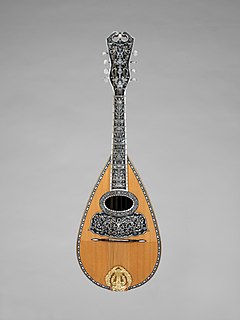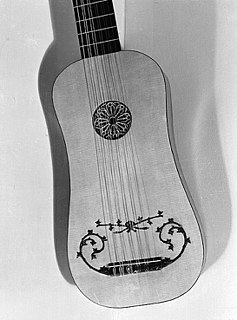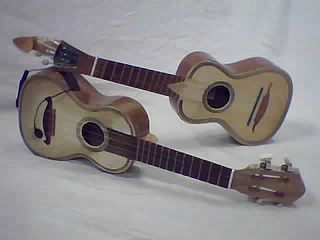
The classical guitar is a member of the guitar family used in classical music and other styles. An acoustic wooden string instrument with strings made of gut or nylon, it is a precursor of the modern acoustic and electric guitars, both of which use metal strings. Classical guitars derive from the Spanish vihuela and gittern of the fifteenth and sixteenth century. Those instruments evolved into the seventeenth and eighteenth-century baroque guitar—and by the mid-nineteenth century, early forms of the modern classical guitar.

The guitar is a fretted musical instrument that typically has six strings. It is usually held flat against the player's body and played by strumming or plucking the strings with the dominant hand, while simultaneously pressing selected strings against frets with the fingers of the opposite hand. A plectrum or individual finger picks may also be used to strike the strings. The sound of the guitar is projected either acoustically, by means of a resonant chamber on the instrument, or amplified by an electronic pickup and an amplifier.

A mandolin is a stringed musical instrument in the lute family and is generally plucked with a plectrum. It most commonly has four courses of doubled metal strings tuned in unison, thus giving a total of 8 strings, although five and six course versions also exist. The courses are typically tuned in an interval of perfect fifths, with the same tuning as a violin. Also, like the violin, it is the soprano member of a family that includes the mandola, octave mandolin, mandocello and mandobass.

The viol, viola da gamba, or informally gamba, is any one of a family of bowed, fretted, and stringed instruments with hollow wooden bodies and pegboxes where the tension on the strings can be increased or decreased to adjust the pitch of each of the strings. Frets on the viol are usually made of gut, tied on the fingerboard around the instrument's neck, to enable the performer to stop the strings more cleanly. Frets improve consistency of intonation and lend the stopped notes a tone that better matches the open strings. Viols first appeared in Spain in the mid-to-late 15th century, and were most popular in the Renaissance and Baroque (1600–1750) periods. Early ancestors include the Arabic rebab and the medieval European vielle, but later, more direct possible ancestors include the Venetian viole and the 15th- and 16th-century Spanish vihuela, a six-course plucked instrument tuned like a lute that looked like but was quite distinct from the four-course guitar.

The bağlama or saz is a family of plucked string instruments, long-necked lutes used in Ottoman classical music, Turkish folk music, Turkish Arabesque music, Azerbaijani music, Kurdish music, Armenian music and in parts of Syria, Iraq and the Balkan countries.

Mato Grosso is one of the states of Brazil, the third largest by area, located in the Central-West region. The state has 1.66% of the Brazilian population and is responsible for 1.9% of the Brazilian GDP.

Mato Grosso do Sul is one of the Midwestern states of Brazil. Neighboring Brazilian states are Mato Grosso, Goiás, Minas Gerais, São Paulo and Paraná. It also borders the countries of Paraguay, to the southwest, and Bolivia, to the west. The economy of the state is largely based on agriculture and cattle-raising. Crossed in the south by the Tropic of Capricorn, Mato Grosso do Sul generally has a warm, sometimes hot, and humid climate, and is crossed by numerous tributaries of the Paraná River. The state has 1.3% of the Brazilian population and is responsible for 1.5% of the Brazilian GDP.

The vihuela is a 15th-century fretted plucked Spanish string instrument, shaped like a guitar but tuned like a lute. It was used in 15th- and 16th-century Spain as the equivalent of the lute in Italy and has a large resultant repertory. There were usually five or six doubled strings.

Campo Grande is the capital and largest city of the Brazilian state of Mato Grosso do Sul in the Center-West region of the country. The city is nicknamed Cidade Morena because of the reddish-brown colour of the region's soil. It has a population of 906,092, according to a 2020 IBGE estimate, while its metropolitan area is home to 991,420 people (2010).

The cavaquinho is a small Portuguese string instrument in the European guitar family, with four wires or gut strings.

The viola caipira, often simply viola, is a Brazilian ten-string guitar with five courses of strings arranged in pairs. It was introduced in the state of São Paulo, where it is widely played as the basis for the música caipira, a type of folk-country music originating in the caipira country of south-central Brazil.

The Federal University of Mato Grosso is a public university in the state of Mato Grosso, Brazil. Responsible for serving the entire state, its main campus is in the capital city of Cuiabá. Smaller campuses are located in Barra do Garças, Pontal do Araguaia, Sinop, and Várzea Grande, while the former campus at Rondonópolis is now the Federal University of Rondonópolis, split off in 2018.

The Federal University of Mato Grosso do Sul, is a public university located in the state of Mato Grosso do Sul in Brazil. It has, in addition to the main campus in Campo Grande, nine campuses located in the following inland cities: Aquidauana, Chapadão do Sul, Corumbá, Coxim, Naviraí, Nova Andradina, Paranaíba, Ponta Porã e Três Lagoas.

The choghur is a plucked string musical instrument common in Azerbaijan and Georgia. It has 4 nylon strings.

Ivan Vilela is a Brazilian composer, arranger, researcher, teacher and viola caipira player. Ivan Vilela is currently a professor at the ECA - School of Communication and Arts of the University of São Paulo. He is the director of the Orquestra Filarmônica de Violas, a Brazilian orchestra composed by Brazilian violas. Ivan Vilela is one of the main ten-string guitarists (viola) nowadays. With a special style and very developed technique, he has more than 15 albums recorded, solo or with different groups, and was nominated for and awarded several prestigious prizes in Brazil.

Braz Roberto da Costa, known professionally as Braz da Viola, is a Brazilian multi-instrumentalist musician, luthier, conductor and teacher. He runs workshops of viola caipira in several cities in Brazil. He played with several guitar players in Brazil, such as Roberto Corrêa, Paulo Freire, Renato Andrade, Pereira da Viola, Ivan Vilela and dual Zé Mulato and Cassiano. He worked with Inezita Barroso, when the singer appeared accompanied by the Orquestra de Viola Caipira de São José dos Campos.

Viola da terra is a stringed musical instrument from the islands of the Azores, closely associated with the saudade genre of Portuguese music. Its 12 or 15 metal strings are arranged in either five or six courses.
The viola da Terceira is a stringed musical instrument of the guitar family, from the Portuguese islands of the archipelago of the Azores, associated with the island of Terceira.
The Rio da Casca Ecological Station is an ecological station in the state of Mato Grosso, Brazil. It protects a partly deforested area of savanna.

Lutes are stringed musical instruments that include a body and "a neck which serves both as a handle and as a means of stretching the strings beyond the body".
























